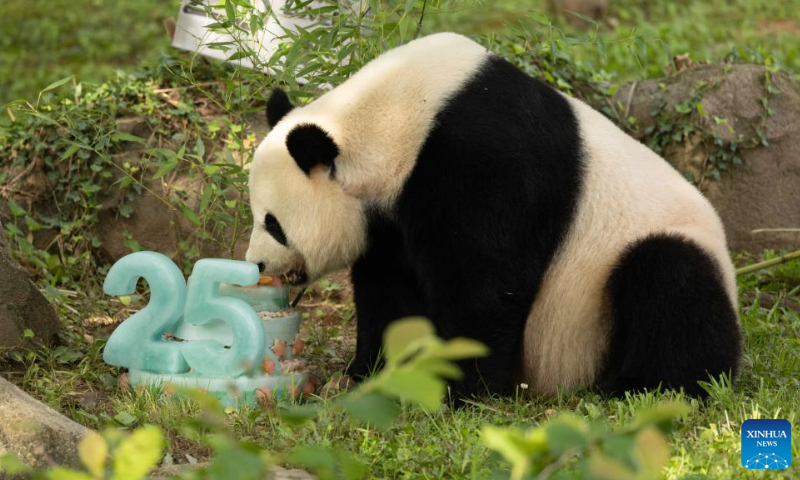Can cute pandas still be seen in the US? With the recent announcement by the Smithsonian’s National Zoo in Washington that giant pandas “Mei Xiang,” “Tian Tian,” and their 3-year-old cub “Xiao Qi Ji” will be sent back to China this month, American public opinion quickly seized on the “sensitive issue,” reporting with astonishment that if the loan agreement for the four giant pandas at Zoo Atlanta expires next year and the pandas also return to China, there could be no pandas in the US for the first time since 1972.
Some American media reflexively attribute this situation to political factors, claiming that “China appears to be gradually pulling back its pandas from multiple Western zoos.” This is pure sensationalism aimed at driving the false narrative that China is no longer friendly toward the US-led West so that to create or strengthen the opinion that “China is becoming more closed.” Despite the clear statement from Brandie Smith, the director of the Smithsonian’s National Zoo in Washington, to the media that negotiations are researcher-to-researcher and not politically driven, many mainstream American media outlets appear disinterested in this statement.
The giant pandas “Mei Xiang” and “Tian Tian” arrived in Washington in 2000. During their stay in the US, they gave birth to a total of four panda cubs, including “Xiao Qi Ji,” born in 2020. The initial loan agreement signed between China and the US was for a period of 10 years. Subsequently, both parties extended the agreement twice, for five years each time. In 2020, China and the US jointly announced another extension of three years of their cooperation, prolonging it until December 7, 2023.
As the agreement is about to expire, “Mei Xiang” and “Tian Tian” are now in their 20s and are facing some age-related health issues. They are no longer suitable for living abroad. For them, 23 years of life in the US is already a substantial period. Returning to their habitat is obviously a better choice. Anyone who genuinely loves and cares for giant pandas, whether Americans or Chinese, will understand this decision and wish “Mei Xiang” and her family all the best.
Giant pandas are “image ambassadors” of China-US friendship and cooperation and a bridge connecting the people of China and the US. This has never changed and will not change. The giant pandas, including “Mei Xiang” and her family, are beloved by a wide array of American citizens. Long lines outside the panda enclosures at zoos are common, and there are numerous panda-related products. DreamWorks’ Kung Fu Panda movie franchise has even produced four installments. Meanwhile, several generations of giant pandas have lived in the US, successfully breeding healthy offspring, which reflects the relentless efforts made jointly by China and the US for panda conservation. It should be noted that this situation is generally similar in the US and other developed Western countries.
Over the past couple of years, some giant pandas have returned to China after their loan contracts expired, while others have had their loan agreements extended. This is normal. The loan standards are in place to ensure the well-being of each giant panda, with contract renewals primarily being a technical matter. However, some Western media outlets have been closely monitoring those contracts that are not being renewed, blowing them out of proportion, and using them to tarnish China’s “diplomatic style.”
Thus, when China gifted or leased giant pandas to the US, some American politicians and media figures sternly warned, with a straight face, that pandas could be China’s “united front tool,” cautioning everyone to be vigilant. However, when pandas in the US need to return to China due to lease expirations, some argue that this might signify the “end” of China’s “panda diplomacy.” In short, they seem determined to tarnish the symbol of warmth, friendship, and cuteness represented by the “giant panda,” turning the word “Panda” into something negative and unfavorable. This not only fuels anger but also evokes a sense of sadness.
The Smithsonian’s National Zoo in Washington was the first zoo to receive giant pandas after Nixon’s visit to China in 1972. It has witnessed the deepening of people-to-people emotions between China and the US in the course of their friendly interactions. In a heartfelt farewell to the panda family “Mei Xiang,” the zoo previously organized a nine-day “Panda Palooza: A Giant Farewell” event. Many residents in Washington DC and visitors from across the US flocked to the zoo to bid farewell to the three giant pandas, creating a heartwarming scene. This is a real-life representation of people-to-people diplomacy between China and the US. Those in the American media who only focus on geopolitics and the anti-China politicians who cannot tolerate giant pandas have a much narrower perspective and a less open heart compared to the average American citizens.




